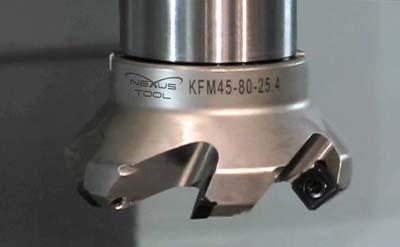
Nexus Cutting Tools, a new product line from Techniks Inc., introduces its patented ShrinkMILL facemill system. The ShrinkMILL uses shrink-fit technology to make a perfect connection between the arbor and face mill for maximized performance. The ShrinkMILL system eliminates any intolerance between the arbor and the facemill, creating an ideal shrink fit connection, according to the company. This reduces vibration and improves runout as well as tool life.
According to Mike Raper, Nexus Cutting Tools National Sales Manager, "The ShrinkMILL system brings the greater rigidity and accuracy of shrink fit to milling applications for faster cutting and better surface finish. Also, scrap rates are reduced and insert life is improved."
The ShrinkMILL system includes Nexus Tool's facemill arbors and facemills that are manufactured to precise tolerances required by the shrink-fit process. Nexus provides complimentary shrink-fit services to its customers who do not own their own machine. Choose from a wide range of Nexus high-precision inserts for all materials as well high-polished inserts optimized for aluminum.
Contact Details
Related Glossary Terms
- arbor
arbor
Shaft used for rotary support in machining applications. In grinding, the spindle for mounting the wheel; in milling and other cutting operations, the shaft for mounting the cutter.
- facemill
facemill
Milling cutter for cutting flat surfaces.
- gang cutting ( milling)
gang cutting ( milling)
Machining with several cutters mounted on a single arbor, generally for simultaneous cutting.
- milling
milling
Machining operation in which metal or other material is removed by applying power to a rotating cutter. In vertical milling, the cutting tool is mounted vertically on the spindle. In horizontal milling, the cutting tool is mounted horizontally, either directly on the spindle or on an arbor. Horizontal milling is further broken down into conventional milling, where the cutter rotates opposite the direction of feed, or “up” into the workpiece; and climb milling, where the cutter rotates in the direction of feed, or “down” into the workpiece. Milling operations include plane or surface milling, endmilling, facemilling, angle milling, form milling and profiling.
- milling machine ( mill)
milling machine ( mill)
Runs endmills and arbor-mounted milling cutters. Features include a head with a spindle that drives the cutters; a column, knee and table that provide motion in the three Cartesian axes; and a base that supports the components and houses the cutting-fluid pump and reservoir. The work is mounted on the table and fed into the rotating cutter or endmill to accomplish the milling steps; vertical milling machines also feed endmills into the work by means of a spindle-mounted quill. Models range from small manual machines to big bed-type and duplex mills. All take one of three basic forms: vertical, horizontal or convertible horizontal/vertical. Vertical machines may be knee-type (the table is mounted on a knee that can be elevated) or bed-type (the table is securely supported and only moves horizontally). In general, horizontal machines are bigger and more powerful, while vertical machines are lighter but more versatile and easier to set up and operate.
